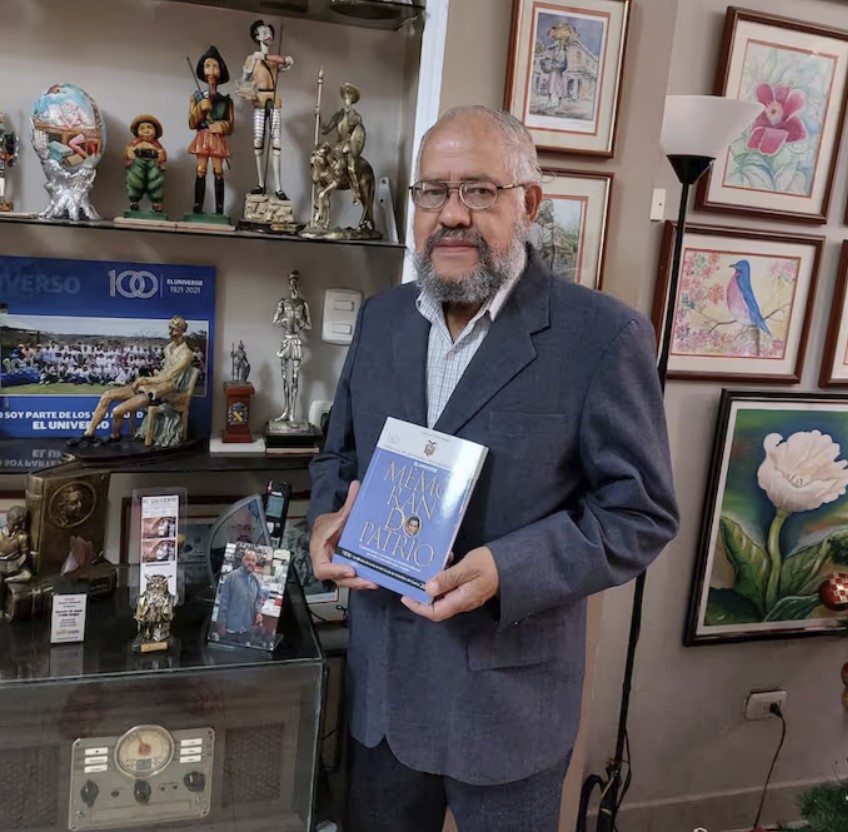Germán Arteta Vargas (Guayaquil, Ecuador, 1940) is a prominent Ecuadorian historian, journalist, educator, and author. Known for his dedication to preserving Ecuadorian history and culture, he has published several influential works, including Guayaquil nostálgico (2009), Cantos a Guayaquil (2011), and Qué chévere (2012). His writing often focuses on civic education, folklore, and national identity. In 2019, he was inducted as a Corresponding Member of the National Academy of History in recognition of his contributions to the historical and cultural heritage of Ecuador.
Literary Career and Contributions
Germán Arteta Vargas is recognized for his work as an educator, social communicator, and historian. His publications explore Ecuador’s cultural history and civic identity, often highlighting key historical figures and traditions. One of his most significant works, Guayaquil nostálgico (2009), reflects on the city’s past, offering readers a thoughtful exploration of its transformation through memories, traditions, and historical narratives. This book rekindles a connection to the city’s heritage and plays a critical role in preserving Guayaquil’s cultural memory.
Another well-received work, Qué chévere: un paseo por los más populares juegos tradicionales de la niñez guayaquileña (2012), delves into the traditional childhood games of Guayaquil. The book captures a unique aspect of the city’s folklore, blending history with cultural nostalgia. His 2014 publication, Personajes populares de Guayaquil, presents an engaging look at the city’s historical figures, providing insight into the prominent individuals who have shaped Guayaquil’s identity.
In addition to these works, Arteta compiled the anthology Cantos a Guayaquil (2011), a collection of over 400 poems by renowned poets, both past and present, dedicated to celebrating Guayaquil’s rich history and cultural heritage. His latest work, Memorando patrio (2021), compiles key historical dates and figures from Ecuadorian history, serving as a vital educational resource.
Journalism and Civic Engagement
Arteta Vargas had a long career at Diario El Universo, where he maintained the educational column Pizarra for two decades. He also contributed to historical columns, including Un día como hoy, Gente con Historia, and Calendario Histórico. His journalistic work further established him as a key figure in documenting and preserving Ecuador’s cultural heritage.
Throughout his career, he held several leadership positions. He served as president of the Círculo de Periodistas del Guayas (Cipeg) multiple times and was an active member of the Benemérita Sociedad Filantrópica del Guayas. He is also affiliated with several historical and cultural organizations, including the Casa de la Cultura Ecuatoriana, the Fundación Regional de Cultura Montubia, the Confraternidad de Historiadores Camilo Destruge, and the Fundación de Estudios Geopolíticos Dr. Antonio Parra Velasco.
Recognition and Achievements
In 2012, Arteta was awarded the prestigious title of “Ciudadano Ilustre de Guayaquil” by the Municipality of Guayaquil. His influence extends beyond literature, as his leadership in civic and cultural institutions continues to shape Ecuadorian society. In 2019, Arteta was inducted as a Corresponding Member of the National Academy of History, recognizing his significant contribution to the study and preservation of Ecuador’s cultural and historical heritage.
Personal Life and Legacy
Arteta Vargas has balanced his roles as an educator, journalist, and historian throughout his long career. Even in retirement, he continues to contribute to the intellectual and historical discourse of Ecuador through his work with various organizations and ongoing collaborations with Diario El Universo.
Selected Works
- Brevario Cívico Estudiantil (1981)
- Guayaquil nostálgico (2009)
- Cantos a Guayaquil (2011)
- Qué chévere: un paseo por los más populares juegos tradicionales de la niñez guayaquileña (2012)
- Personajes populares de Guayaquil (2014)
- Al maestro (2016)
- Memorando patrio (2021)
References
- Academia Nacional de Historia, “Germán Arteta Vargas fue incorporado como Miembro Correspondiente.” Retrieved on October 20, 2024. Click to view.
- Universidad de Guayaquil Library Catalog, “Cantos a Guayaquil.” Retrieved on October 20, 2024. Click to view.
- Desde mi Trinchera, “Germán Arteta Vargas: Nuevo miembro de la Academia Nacional de Historia.” Retrieved on October 20, 2024. Click to view.
- El Universo, “Germán Arteta: Un nuevo baluarte para la Academia Nacional de Historia.” Retrieved on October 20, 2024. Click to view.
- El Universo – La Revista, “Libro ‘Memorando patrio’ de Germán Arteta Vargas reúne las fechas históricas imprescindibles del Ecuador.” Retrieved on October 20, 2024. Click to view.
- Google Books, “Qué chévere: un paseo por los más populares juegos tradicionales de la niñez guayaquileña.” Retrieved on October 20, 2024. Click to view.

